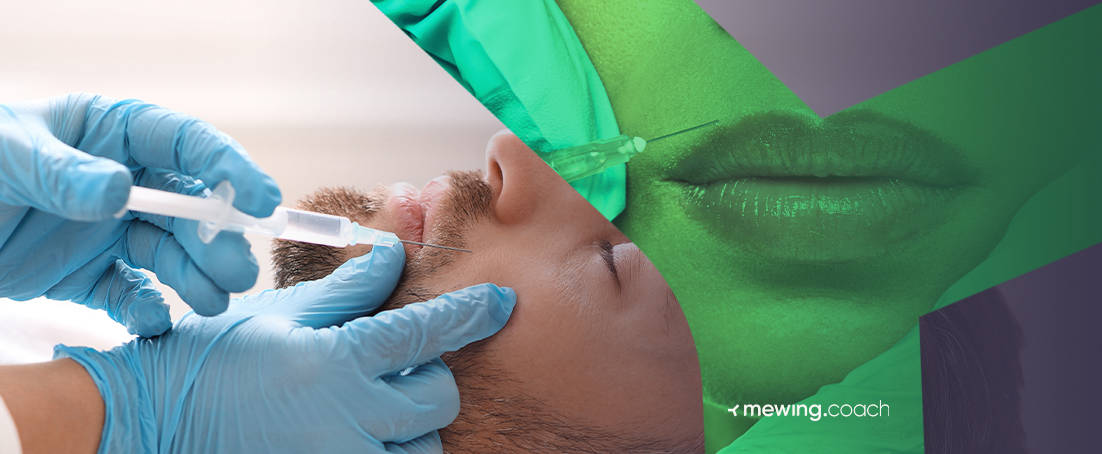Dermal fillers generally last between 6 to 12 months, but longevity can vary based on factors such as the type of filler, treated facial area, and individual metabolism. Regular maintenance treatments are necessary as the body gradually absorbs the filler material. The longevity of fillers is also influenced by the specific injection technique and the patient’s lifestyle habits.
Whether it’s to reduce the appearance of smile lines or crow’s feet, sun damage, or to plump up the cheeks, and lips, a lot of people undergo different procedures. One popular way to do it is by trying out a filler treatment. Dermal filler injections are used to make up for the lost volume of the face, or body, brought on usually by aging or specific medical disorders.
Be that as it may, many people wonder do fillers ever look natural, or how often they need to be replaced. Does a filler make you look older after it wears off? Are there tricks preventing the face sagging naturally? Let’s find out.
In this article you will also read about:
- 👄 What are dermal fillers?
- 🕛 How long do fillers last?
- ⏩What influences the filler’s longevity?

What are Dermal Filler Injections?
Dermal fillers injections are gel-like material and are injected beneath the skin, intended to provide a smoother or fuller appearance of the facial or body features. One of the ways to reduce the fine lines around mouth, reverse aging process or fix wrinkles and lost volume is by using this method, as it provides fast transitory results.
So, how long do dermal fillers last? Well, the majority last 6-12 months. However, to sustain the dermal filler result and intended effect, the injections need to be constantly repeated because the filler material is made of substances that the body eventually breaks down and absorbs.
Botulin Injections vs Dermal Fillers
To begin with, a clear distinction needs to be made. Botox is NOT a dermal filler, although many confuse the two.
Botox is actually a brand for a medication named botulinum toxin type A, which is a neuromodulator. The method by which it functions is by temporarily paralyzing the muscles that are known to cause wrinkles and fine lines, for example on the forehead or around the mouth and eyes.
On the contrary, dermal fillers act by adding volume on the surface of the skin, smoothing out fine lines and wrinkles, most often made of hyaluronic acid (HA), collagen or other materials.
Botox and dermal fillers are each injected to the skin, although they utilize different action mechanisms and treat different types of lines and wrinkles. Both are considered alternative methods to get rid of smile lines without surgery, however, there are also 0ther various extremely effective techniques to improve the skin elasticity naturally.
Factors that Affect the Longevity of Fillers
Several factors can affect the filler’s longevity. Here is a list of some of them.
- Type of filler used
Not all filler is made of the same materials since they each target a different area of the face. Because some of these may degrade far more quickly than others due to their biodegradability, different dermal fillers have different metabolic rates. However, it is well-known that a filler’s effects will persist longer the higher the HA (hyaluronic acid) content it contains. - Face Area Treated
The effects of a filler treatment are most likely to wear off more rapidly if they are injected in a highly mobile part of the face, such as the lips or the area surrounding the mouth, because those muscles are constantly contracting. Contrarily, due of their positioning, which is typically on the bone and beneath the muscles, cheek and under-eye filler can last longer. - Filler’s Particle Size
Particles are groups of various molecules, like HA molecules, that are joined together. The particle size is larger if the molecules in a product are bound together into larger bigger groups. The filler will remain in the body for a longer period of time if the particle size is larger. - Amount of Fillers Used
Logically, smaller injection doses will wear off more quickly than larger doses. The injectables will also last longer in locations that require multiple injections and are close together. - Your Age and Skin Type
The best time to start an anti-aging program with injectables is before you even notice aging signs, and lost volume. Although getting a dermal filler at a young age may seem like a waste of time, it might delay the onset of aging and preserve your youthful appearance. Also, the speed the body brakes the filler substance varies depending on skin type. - Technique of Injection Used:
- Tunneling technique – The preferred and safest and most natural-looking method.
- Stretching technique – Fill in areas with significant loose skin.
- The point technique – Used for skin’s deeper layers.
- The dual-plane technique – Utilized in high-movement areas.
- Micro-papular technique – Injected in tiny droplets into the dermis’s most superficial layer.
- Your Lifestyle Habits
Different lifestyles or habits may influence the expected duration of a filler, like more exposure to UV light can reduce dermal filler longevity. Also, if you are a smoker you are probably not fond of those smokers’ lines, and although there are many vertical upper lip line reduction tips, some choose injectables. The longevity of a dermal filler is not yet proven to be affected by smoking, but many suspect it.
Dermal Fillers Types Explained
Dermal fillers come in various forms and under many names. To help you better understand, we’ve compiled a list of the most common ones.
Hyaluronic Acid Fillers (HA) (e.g. Juvederm, Restylane)
Hyaluronic acid is a natural substance that your skin already contains. It helps keep skin hydrated and plump. Typically, a HA filler is gel-like material, and the effects last for 6 to 12 months before the body completely absorbed the particles.
Brands like Restylane and Juvéderm offer different HA filler types to approach cosmetic concerns. Sharing similar ingredients, it is difficult to distinguish between the two. They are mostly used to treat the same problems.
Collagen Fillers
Cosmetic plastic surgery uses collagen injectable fillers, also known as soft-tissue augmentation, to fill in wrinkles, skin depressions, and/or scarring. The procedure is implemented by injecting collagen into the skin to boost the treated area.
Calcium Hydroxylapatite Fillers (CaHa)
An injectable dermal filler containing uniform CaHA is known as calcium hydroxylapatite (CaHA). It is thought to last longer, and it is very biocompatible with human tissue. Injectables containing CaHA from the Radiesse brand have been FDA-approved.
Poly-L-Lactic acid Fillers (PLLA) (e.g. Sculptra)
Collagen-stimulating treatment, penetrates deep within the skin using poly-L-lactic acid (PLLA). PLLA, in contrast to HA, aids in the stimulation of the skin’s own natural production of collagen. Sculptra is the most well-known manufacturer of this type of filler.
Polymethylmethacrylate Fillers (PMMA) (e.g. Bellafill)
PMMA, a semi-permanent filler, is typically applied to treat moderate-to-deep wrinkles, folds, and furrows, particularly nasolabial folds, enhance thin lips and fill in pitted scars. Bellafill is a prescription PMMA injectable.
Silicone Fillers
Injecting silicone into the tissue to alter facial and body shapes. The FDA has outlawed this practice, which began in the 1960s, following numerous reports of potentially fatal complications.
Autologous Fat
The procedure known as autologous fat transfer involves removing fat from one area of the body and injecting it into another. The buttocks and breasts are the most common locations for this, but the face and neck are also common places.
Polyalkylimide
Polyalkylimide is a semi-permanent synthetic material used by plastic surgeons to treat deeper wrinkles like nasolabial folds and depressed scars. Fine wrinkles are typically not treated with polyalkylimide.
Polyacrylamide
This filler is a transparent, colorless gel, typically injected into the nasolabial and glabellar folds, depressed mouth corners, and perioral wrinkles, used for facial contouring, such as lip augmentation and chin, cheek, nose, and vermilion border contouring. There have been some reports of complications from this procedure.
Dermal Fillers Based on Treatment Area
Just below is a list of the most popular lines and brands of injectables. Some of these brands are FDA approved.
- Juvederm: Hyaluronic acid-based filler collection, used to add facial volume, and plump cheeks, and lips, and reduce dark circles under the eyes.
- Restylane: A hyaluronic acid filler family of products, mostly utilized for adding volume to the cheeks, lips, and under the eyes.
- Sculptra: This is a poly-L-lactic acid dermal filler used to offset loss of volume to cheeks and other facial areas.
- Radiesse: Based on calcium hydroxyapatite, this dermal filler is used to plump cheeks and other areas of the face.
- Belotero: Another Hyaluronic acid-based filler, used to fill up fine lines and wrinkles.
- Voluma: One more in the line of hyaluronic acid dermal fillers. The Juvederm Voluma is specifically used to deal with cheeks volume, an alternative to cheek augmentation.
- Teosyal: Hyaluronic acid fillers are best used for filling wrinkles and for lip enhancement.
- Revanesse: A dermal filler based on the hyaluronic acid gel, generally used for plumping up cheeks and other facial areas.
- Versa: Hyaluronic acid-based fillers that are used to smooth and fill fine lines or wrinkles and to add volume to the lips.
How Long Do Different Dermal Fillers Last
You are not sure how to get rid of the bunny wrinkles, and you don’t know how long do fillers last? The longevity may vary due to the application location as well.
Forehead Fillers
Depending on the type and thickness of the filler, a forehead filler can last from 6 months up.
Upper Eyelid
After the procedure, the hyaluronic acid filler will last anywhere from six months to one year, making your eyelids appear fuller. The eyelid region is frequently treated with Restylane injectables.
Under Eye Fillers
Due to the delicate eyelid skin, less viscous HA fillers like Restylane, Restylane Silk, and Juvederm Ultra are typically recommended. The results can be seen immediately and last anywhere from 3 to 6 months, depending on a person’s metabolism. An enzyme injection that dissolves the HA can be used to reverse the results if you are dissatisfied with them.
Cheek Fillers
How long do cheek fillers last? Due to your frequent movements, cheek fillers may last a bit less, but generally from 6 to 12 months. A longer-lasting filler for the cheekbones is Teosyal Ultra Deep.
Lip Fillers
It typically takes two weeks for the lips to settle after treatment. But how long do lip fillers last? Generally from six to eight months. They dissolve more quickly in younger people.
Jawline Fillers
How long does jaw filler last? A jawline filler will require to be repeated every 6 to 18 months.
Nose
Depending on the product, injectable nose filler can last from 12 to 18 months, because there is not a lot of movement in that area.
Fillers for Temples
Temple fillers are a famous alternative to surgery and last anywhere from six months to two years.
Midface Fillers
They can last anywhere from 3 to 18 months.
Fillers for Nasolabial Folds
While fillers for nasolabial folds last for a longer time, they won’t have a permanent effect. These injectables last anywhere from 6 to 18 months in total.
Jaw Angle Fillers
You will need to repeat injections every 6 to 18 months on the jaw angle area.
Marionette Lines
Marionette line injections have a visible effect for 6 to 12 months.
Chin Fillers
How long does chin filler last? With touch-up treatments, chin augmentation with fillers like Juvederm Voluma, Radiesse, or a combination of the two can produce results that last anywhere from 15 to 24 months.
What happens when fillers wear off?
If you think about your glabbelar lines and how to even them out, you may decide to go for an injectable, but make sure you know the downsides first. Besides the dermal filler not being a permanent treatment, many are worried about how your lips or face will look after the visible results wear off. This technique can cause the skin to stretch in the long term, so after the procedure, your skin may become even saggier. That can make us wonder, do fillers make you look older? It’s possible.
There are also a few other risks, in some cases, the filers may have a negative impact on your overall appearance; or unwanted lumps and asymmetries to skin necrosis and blindness. So, are fillers safer than Botox? Probably yes, but they don’t come risk-free.
How often do you need fillers replaced?
Every filler injected need to be replaced. Typically, the follow-up appointment needs to be done within the first year, so you don’t risk your face sagging after the result wears off. For each syringe of Juvederm, you can anticipate paying anywhere from $500 to $600 or more. Many consider these procedures to be quite a price, especially in the long-term
Another point is how long until filler looks normal on you. The recovery time can take weeks to a month till the filler sets. There are also natural ways to get rid of marionette lines and ways to eliminate mid-cheek lines without cosmetic procedures. Some articles indicate that facial blood circulation improvement methods can affect the quality of the skin.
What if You Aren’t Happy with the Results?
What happens after years of fillers? Some people may experience those downsides mentioned above, like having saggier skin after the instant results dissolve. Luckily, there are many other more natural methods to put off ageing symptoms and retain a youthful appearance, for those that are not willing to go with risky procedures.
Many would rather change their lifestyle, eat healthier, and use sunscreen and cosmetic products like HA serums and similar to maintain and improve their skin quality without the side effects of the aesthetic procedures.
Also, a very famous method used for reversing the ageing process is the mewing technique. It teaches you how to fix your tongue posture, and improve your facial features. The mewing benefits on different parts of the face are obvious after only a few weeks of practice. You can download the mewing.coach app to find effective tongue exercises and look more youthful in a natural way.
Conclusion
Like the rest of us, you wonder what facial features aren’t attractive and whether you need to do something to alter your appearance. Dermal fillers do provide fast results, and are relatively safe, but not riskless. However, if you decide on it, make sure to check with a skilled practitioner to find out who should not get fillers.
Still, the worries remain, will you still have wrinkles after fillers or will they get even worse? It is possible. Luckily, there are ways to naturally reduce horizontal neck lines. Don’t forget to check out the healthier ways to deal with ageing. Drink plenty of water, exercise mewing regularly and don’t forget to put on some sunscreen!



